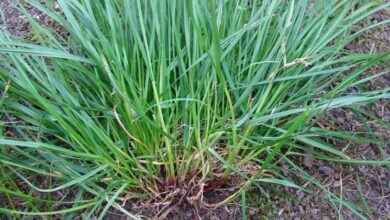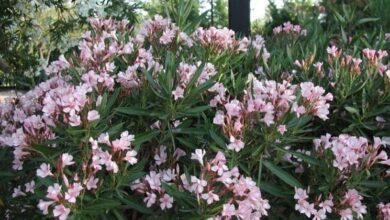Wind resistant plants

There are plants that are born in adverse conditions and that is why they must adapt to the habitat and create the most ideal conditions to survive. Factors such as extreme salinity, droughts, desert climates, frosts or strong winds force plants to find viable alternatives that help them continue living. The latter is especially important, since depending on their speed it could even tear them off the ground.
Therefore, if you live in a windy area, we are going to talk about wind resistant plants, those plants that must withstand winds of several kilometers in speed and remain stoic.
How the wind affects

Image – Wikimedia/ michael clarke stuff
The movement of air in the atmosphere causes the wind, a factor that causes the rapid dehydration of plants in addition to drying out the soil and affecting the parts of the specimens. Stems, leaves and branches can be affected by gusts that threaten their fullness and integrity, especially in areas prone to hurricanes or in places near the sea where it is also a wind that is accompanied by salt.
To resist the wind, these plants have adapted over time and generations and this is how they have stronger tissues both in their branches and in the trunks. This is one of the variants although there are also plants to which the opposite has happened: their branches or stems have become more flexible in order to accompany the swings of the wind without breaking.
In other cases, the plants have stopped their height or have acquired more rounded shapes so as not to suffer the ravages of the gusts that threaten their integrity. These alternatives also help to avoid dehydration. But if this is not enough, in areas where the wind blows strongly in a predominant direction, plants grow in that direction.
Plant care
If you live in a place with strong winds, you can help your plants by placing stakes so that the plants can lean on them, especially during the first years and when they are weaker. Another viable alternative is to cover them with natural protective screens, that is, you can plant some wind-resistant specimens such as certain bushes to protect them. A third option is to protect them with artificial screens such as panels or lattices. And a fourth is to look for plants that are resistant to the wind .
Selection of wind resistant plants
If you are looking for some that can help you protect your garden from the wind, and/ or that are capable of living well in windy conditions, write down:
Plants for windy terraces
There are many plants that can be grown in pots and that are ideal for windy areas, among them we find the following:
Palmetto

Image – Wikimedia/ Canaan
The palm heart, whose scientific name is Chamaerops humilis, is a multicaule palm -that is, with several trunks-, native to North Africa and Southeast and Southwest Europe. It is usually found near the coast, where there can be intense gusts of wind.
It grows up to 4 meters in height, and develops palmate leaves divided into 24-32 green or bluish leaflets. It resists drought and high temperatures very well, as well as weak to moderate frosts.
Rosemary

Image – Flickr/ SuperFantastic
Rosemary, whose scientific name is Rosmarinus officinalis, is an aromatic plant native to the Mediterranean region. It lives well on the coast, where the winds can be strong. In addition, it resists drought and high temperatures very well, although moderate frosts do not harm it.
It reaches a height of around one meter, although it can be pruned in late winter to make it smaller, so it is grown both in the garden and in pots.
Kumquat

Image – Wikimedia/ Василий Герман
The kumquat, also known as Chinese orange or dwarf orange, is a shrub or small tree belonging to the genus Fortunella. It is originally from China, and it is resistant to wind and sun.
It grows only up to 5 meters in height, with a rounded crown made up of green leaves. It produces fruits similar to oranges, but much smaller, and with a bitter taste. It requires moderate watering, but otherwise, it supports moderate frosts.
Rush

Image – Wikimedia/ Meggar
The rush, belonging to the genus Juncus, is a plant native to the Mediterranean basin, where it lives on banks and swamps, as well as in other humid places. He doesn’t dislike the wind, which is why he deserves to be on this list.
It develops stems up to 3 feet tall, and blooms from April to July, producing small, brownish compound flowers. It needs very frequent waterings.
Plants for windy gardens
If you want to put wind resistant plants in a garden, we recommend the following:
Privet

Image – Wikimedia/ MurielBendel
The privet, also known as henna, whose scientific name is Ligustrum vulgare, is an evergreen shrub native to Europe and Asia. It lives without problems in highly exposed areas, which is why it is used so much as a hedge in gardens with sun and wind.
It grows to 2-3 meters in height, and produces very showy white flowers in spring. In cultivation it requires moderate watering, but it is not harmed by cold or frost.
Flowering dogwood

Image – Wikimedia/ Agnieszka Kwiecień, Nova
The flowering dogwood or flowering bloodlet, whose scientific name is Cornus florida, is a deciduous tree native to eastern North America. It is a very resistant plant, in addition to being precious, which is great as an isolated specimen or as windbreak hedges.
It grows up to 10 meters in height, and produces white flowers in great numbers during the spring. It requires frequent watering, although it resists moderate frosts without difficulty.
Evonimo

Image – Wikimedia/ H. Zell
The eponymous, also known as boxwood, bonnet, bonnet of priest or husera, is a deciduous shrub native to central Europe. Its scientific name is Euonymus europaeus, and it is a plant that is widely used as a windbreak hedge in gardens.
It reaches a height of 3 to 6 meters, with green lanceolate leaves. In order to grow, it requires moderate watering and a sunny exposure.
Oron

Image – Wikimedia/ Salicyna
The orón or asar, whose scientific name is Acer opalus, is a deciduous tree native to southern and western Europe, where it lives in the hills and mountains. Thanks to the conditions in which it lives in the wild, it is an ideal plant for windy gardens.
It can reach a height of 20 meters, with a rounded and open crown. It is also quite resistant to pruning, but extreme droughts harm it a lot, so it is advisable to water it immediately. Resists moderate frosts.
Sun and wind resistant outdoor plants
Sometimes the circumstances exist that the land available to put plants, whether in pot or on the ground, is exposed to the wind and also to the sun. When that happens, we have to look for plants that are very resistant to both, like these:
Lavender

Lavender, also called lavender, lavender or lavender, is a plant belonging to the Lavandula genus. Native to the Macaronesian and Mediterranean regions, it is a bush or subshrub that we will find even in gardens near the coast.
It reaches a maximum height of one meter, and during the spring it fills with numerous lavender-colored inflorescences. In addition, it resists drought and weak to moderate frosts very well.
Cape Milkmaid

The Cape milkmaid, whose scientific name is Polygala myrtifolia, is an evergreen shrub native to South Africa. It has a very high ornamental value, especially when it is in flower, and it is a very interesting species for gardens and coastal terraces or exposed to the wind.
It reaches 2 meters in height, rarely 4 meters, and blooms during the spring producing purple flowers. It loves the sun, and is also somewhat drought resistant. The only drawback is that it requires protection against moderate and strong frosts.
Common linden

Image – Wikimedia/ Radio Tonreg from Vienna, Austria
The common linden, also known as broad-leaved linden or large-leaved linden, and whose scientific name is Tilia platyphyllos, is a deciduous tree with a pyramidal crown native to the forests of Europe, where it usually grows accompanied by beech, maples, rowan trees or pines, among others.
It grows to 30 meters in height, and its flowers bloom from late spring to summer. It needs frequent waterings because it does not resist drought. However, it is perfect for temperate or mountainous climates as it supports moderate frosts.
Washingtonia

Image – Wikimedia/ Alejandro Bayer Tamayo from Armenia, Colombia
The Washingtonia, or fan leaf palm, is a palm native to the southwestern United States and northwestern Mexico. It grows at a good rate, reaching up to 50 centimeters per year if it has some water. It is common for it to be planted in exposed areas.
It reaches a maximum height of 20 meters, with a trunk that can be thin ( Washingtonia robusta ) or thick (




